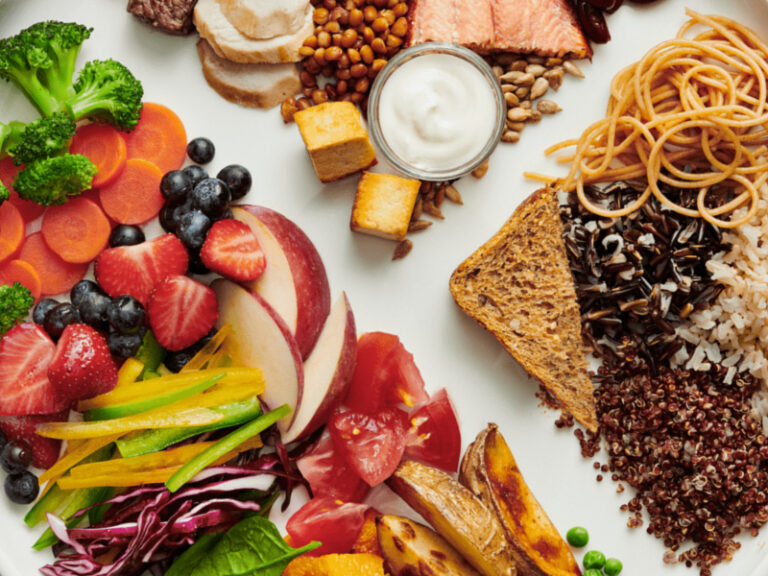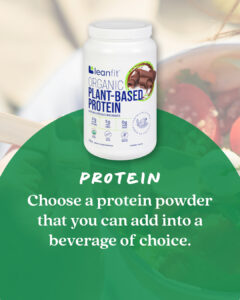
It’s hard to know what we should put on our plates these days! One moment we are told that something is good for us, and then the next moment we are told that it is harming our health. Living in the information age is downright exhausting! Hearing so many different opinions from a variety of sources can make healthy eating confusing and difficult to navigate.
On top of that, we have to contend with deceptive labeling on food packaging from certain manufacturing companies, making health claims on ultra processed foods and creating the illusion that adding a bit of fibre will make up for the fact that the product is overall unhealthy and jam packed with preservatives, artificial coloring, and sweeteners. Is convenience really worth sacrificing our health for? What are the long term impacts of eating these ultra processed foods? How do we return back to the basics, the way food was before it turned into a science experiment?
Let’s explore the key components of a healthy diet and how you can bring all those components together on your plate at each meal. Try to choose minimally processed foods more often, and opt for organic and locally sourced products when possible. For budget friendly options and deals, check out local farmer’s markets before they close up for the week, or check in with local growers or farmers to find out what deals they offer.
Here are the some of the key components of a healthy diet to include daily:
Packed with fibre, antioxidants and a wide variety of nutrients, fruits and vegetables should make up a large portion of your diet. The overall health benefits of eating at least 5 servings a day of fruits and vegetables (2 servings of fruit and 3 servings of vegetables) are significant! It can slash your risk of death from most causes by 13%, lowers your risk of developing COPD and dying from a respiratory disease by 35%, improves cardiovascular health, and it lowers risk of death from cancer by 10% (1).
Focus more on non-starchy vegetables such as, leafy greens, broccoli, cauliflower, cabbage, asparagus, cucumber, celery, peppers, mushrooms, zucchini, sprouts and onions. Starchy vegetables did not have the same health benefits as non-starchy vegetables when it came to preventing certain health conditions and reducing overall risk of mortality (1). Opt for fruits that are high in fibre and rich in a variety of antioxidants. Select from a colorful array of fruit such as berries, melons, grapes, pomegranates, apples, stone fruit and oranges. The more variety that you have in your diet, the more diverse your gut bacteria will be. A more diverse gut microbiome contributes to better overall health and well-being.
 Protein
ProteinAlso known as the building blocks of life, protein is found in every single cell in the human body! That makes this macronutrient incredibly important to obtain through our daily diet. Protein is broken down into amino acids and is used in the body for growth, regulating the immune system, healing, for neurotransmitter production, making hemoglobin, and for making hormones and enzymes. Pretty important, right? You can obtain enough protein through plant or animal sources. There is a common misconception that plant sourced protein is completely missing certain amino acids and that is not true. It may be quite low in certain amino acids, but not completely lacking. If you are eating mainly plant based, make sure to consume a wide variety of plant based protein sources so that your body can combine the varying amino acids from the different sources and create complete proteins (2). If you are an omnivore, try to include more plant based sources of protein daily to benefit from the extra fibre and many other nutrients that they contain.
Plant based protein sources – Tofu and other soy products, legumes/pulses, lentils, nuts, seeds (this includes wild rice and quinoa).
Animal based protein sources – Lean cuts of meat, chicken, pork, wild game, fish, eggs, dairy products, goat’s milk products,
The current RDA for protein for adults is 0.8 grams/kg of body weight each day. Remember that this is the bare minimum that you should consume daily, and your dietary needs may be higher depending on your activity level, what stage of life you are at, or specific health issues. Some people require a low protein diet due to certain health conditions (CKD or PKU). Talk to your doctor or a dietician if you need specific recommendations that are tailored to your needs.
Unfortunately grains have gotten a bad rap for the past couple of decades, mainly because of its connection with refined grains and anti-nutrients such as lectins and phytates that are found in whole grains. This opinion may go against the grain…..but grains aren’t as bad as they have been made out to be. Whole grains have been in the human diet for approximately 10,000 years and were staples for many ancient civilizations. They contain many nutrients in them such as fibre (soluble and insoluble), many b-vitamins, trace minerals, and phytochemicals that can help reduce the risk of developing certain diseases like type 2 diabetes, cancer and heart disease (3). Soaking and cooking your grains will help to reduce the amount of lectins and phytates, making them easier to digest and making nutrients more bioavailable.
Two to three servings of whole grains is enough to reap the health benefits that they offer (3). Choose whole grains that are higher in fibre such as bulgur, teff, barley, buckwheat, oats, amaranth, farro, millet and rye. Fibre can help prevent constipation, lower cholesterol and blood pressure, and can help improve the gut microbiome. Aim to get between 25-38 grams of fibre a day from soluble and insoluble fibre sources (4).
After being villainized for numerous decades, thanks to the low-fat craze that swept through western societies, fat is finally back in our diets again. Healthy fats are important for absorbing
certain vitamins and minerals, building healthy cells, insulating the nerves, optimal brain health, hormone production and energy production. There are two main types of fats, saturated fats and unsaturated fats.
Saturated fats – try to limit consumption of saturated fats daily. Studies have shown that excess consumption of saturated fats, especially in combination with high carbohydrate intake, can cause inflammation and cardiovascular disease. Is it the saturated fat, or is it likely the refined carbohydrates causing this (5)? There is a lot of conflicting evidence and further studies are needed to determine the health implications of eating saturated fats. Until there is more clarity on this issue, consume saturated fats in lesser amounts in comparison to unsaturated fats. Sources of saturated fats are full fat dairy, red meat, coconut and palm oil, poultry with the skin, lard and tallow.
Unsaturated fats – there are two types of unsaturated fats, polyunsaturated and monounsaturated fats. These fats are known as the “healthy fats”. They can help lower LDL cholesterol, increase HDL cholesterol, reduce inflammation (Omega-3), they are important for brain health and they may help to regulate blood sugar. Sources of monounsaturated fats are olive oil, safflower oil, avocados, peanut butter, nuts and seeds. Sources of polyunsaturated fats are flaxseed oil, sunflower oil, nuts and seeds, fatty fish (omega 3), egg yolks, and tofu.
Daily recommendations can vary depending on what stage of life you are in, your activity levels and what health conditions you are dealing with. Talk more with your doctor or dietician for an accurate assessment of your daily fat needs.
Trans Fats – I’m sure by now you have heard about trans fats and their negative impact on health. This is the most detrimental type of dietary fat that you can consume. Industrially produced trans fats are created when vegetable oil is hydrogenated and turned into a solid. This is often used in processed foods, as it is cheap to produce and can remain solid at room temperature. Industrially produced trans fats can be found in many processed foods like baked goods, margarine, vegetable shortening and Vanaspati ghee. Trans fats occur naturally as well, but in much smaller amounts than what you would find in processed foods. Naturally occurring trans fats are found in meat and dairy foods and can be just as detrimental as industrially produced trans fats (6). Trans fats have been linked to an increased risk of stroke, heart disease, type 2 diabetes, dementia and inflammation. Avoid consuming trans fats at all costs, as its long term health consequences are significant.
Fermented foods have become quite popular in recent years, and for good reason! They offer numerous health benefits, especially when it comes to improving gut health. Fermented foods are rich in probiotics and prebiotic fibres, they contain antioxidants and have anti-inflammatory properties (7). Popular fermented foods that are delicious and fairly easy to find are kombucha, kefir, yogurt, sourdough bread, tempeh, natto, miso, sauerkraut and kimchi. Try to include them in small amounts alongside your meals each day.
Here is how to build a healthy, balanced plate that features each key component.
Source: © All Rights Reserved: Canada’s Food Guide: Plate. Health Canada.
Aim to fill half of your plate with colorful fruits and/or vegetables, a quarter of your plate should be whole grains, and the other quarter should be reserved for protein. Add a small serving of fermented foods on the side, and choose water if you need a beverage with your meal.
Fitting in all of these components at each meal may not always be possible. Travel, working multiple jobs and constantly being on the go can make healthy eating difficult. Here are some options for each category that can be utilized when you are unable to make a healthy meal.
Fruits and vegetables – Opt for a greens powder that contains a wide variety of fruits, vegetables and grasses. This can be added into a smoothie or water to take with you when you are on the go.
Protein – Choose a plant based or animal based protein powder that you can add into a beverage of choice
Fibre – Psyllium husk, acacia gum fibre and inulin can provide fibre to help prevent constipation when travelling.
Healthy fats – Algae oil or fish oil can help provide a source of Omega-3, or try an Omega 3-6-9 blend to include a variety of fatty acids.
Fermented foods – Kombucha is fairly portable and a delicious way of getting in some fermented goodness, but if you need something easier to bring along during travel, choose a fermented probiotic supplement.
Remember to always opt for whole food options when you can, as some products listed above are ultra processed and may be missing other nutrients that whole foods contain. Opt for unflavored when possible to avoid unnecessary sweeteners and flavors that are often added in.
Ultra processed foods (UPFs) are foods that are highly processed, energy dense, they have little nutritional value and do not satiate your hunger. They tend to be high in sugar but low in fibre and nutrients. They often contain unhealthy fats, preservatives, chemicals and sweeteners like high fructose corn syrup. This can be the packaged baked goods at the local supermarket, or it can even be those “healthy” granola bars at the health store. UPFs have been linked to the development of obesity, heart disease, type 2 diabetes, mental health disorders and an overall higher all-cause mortality risk. One study reported that consuming more than 4 servings a day of UPFs increased all-cause mortality risk by 62% (8). It is important to check the labels when buying packaged goods to avoid foods that contain undesirable and potentially harmful ingredients that can destroy your health over time.
Just as important as the foods we eat, the thoughts and feelings we bring to each meal can affect our digestion and our ability to recognize when we are satiated and should stop eating. Eating on the go or when feeling stressed can activate the body’s fight or flight stress response. This can divert blood flow away from your stomach, leading to indigestion and bloating. Long term chronic stress can have a lasting impact on the digestive system and has also been linked to IBS, IBD, GERD, and many other digestive disorders. It is important to get chronic stress under control before it starts to negatively impact your overall health.
Here are some tips to help you become more present during your meals and promote better digestion:
Practice Mindful eating – When was the last time you paid attention to the way your food looks or the way it smells? Take a moment before eating to observe the food you are about to eat. Notice the colors, the smells and savor the flavors as you eat. Release any stress or worries in your mind and bring in the mindset of gratitude for what you have. This will help enhance digestion and your overall eating experience.
 Hara hachi bun me – This is a Japanese proverb that means “Eat until you’re 80% full”. Originating from Confucian teachings, the idea behind this concept is to eat just enough to nourish your body without feeling overly full (9). Pay attention to cues that you are getting full, and stop eating when you feel satisfied but not yet full.
Hara hachi bun me – This is a Japanese proverb that means “Eat until you’re 80% full”. Originating from Confucian teachings, the idea behind this concept is to eat just enough to nourish your body without feeling overly full (9). Pay attention to cues that you are getting full, and stop eating when you feel satisfied but not yet full.
Manage stress with herbs – Herbs like Holy Basil (Tulsi) and Chamomile can help reduce your stress levels and improve digestion. Both herbs have calming and relaxing properties and can help reduce gas, bloating and indigestion. They can be taken as a tea throughout the day, or taken as a supplement for convenience.
Consider digestive enzymes – Certain situations call for digestive enzymes or digestive bitters to help improve digestion. If you are going through an intense period of stress or illness, you may benefit from taking a full spectrum digestive enzyme for that duration of time.
Always speak with your health care provider before making changes to your diet or before starting new supplements. The advice in this article is for educational purposes only, and was written for anyone who is looking for general advice when starting out on a new health journey. The advice given here does not replace dietary recommendations that have been given to you by your healthcare provider. Remember that dietary changes should be made gradually to allow the body to easily adapt to those changes over time.
Article written by Jennifer Fraser C.H.N.C.
References:
1. https://pmc.ncbi.nlm.nih.gov/articles/PMC8084888/#S18
2. https://pubmed.ncbi.nlm.nih.gov/31690027/
3. https://pmc.ncbi.nlm.nih.gov/articles/PMC5310957/#s0030
4. https://www.canada.ca/en/health-canada/services/nutrients/fibre.html
5. https://www.sciencedirect.com/science/article/pii/S0735109720356874#sec9
6. https://www.who.int/news-room/fact-sheets/detail/trans-fat
7. https://pubmed.ncbi.nlm.nih.gov/28945458/
8. https://www.bmj.com/content/365/bmj.l1949
9. https://en.wikipedia.org/wiki/Hara_hachi_bun_me